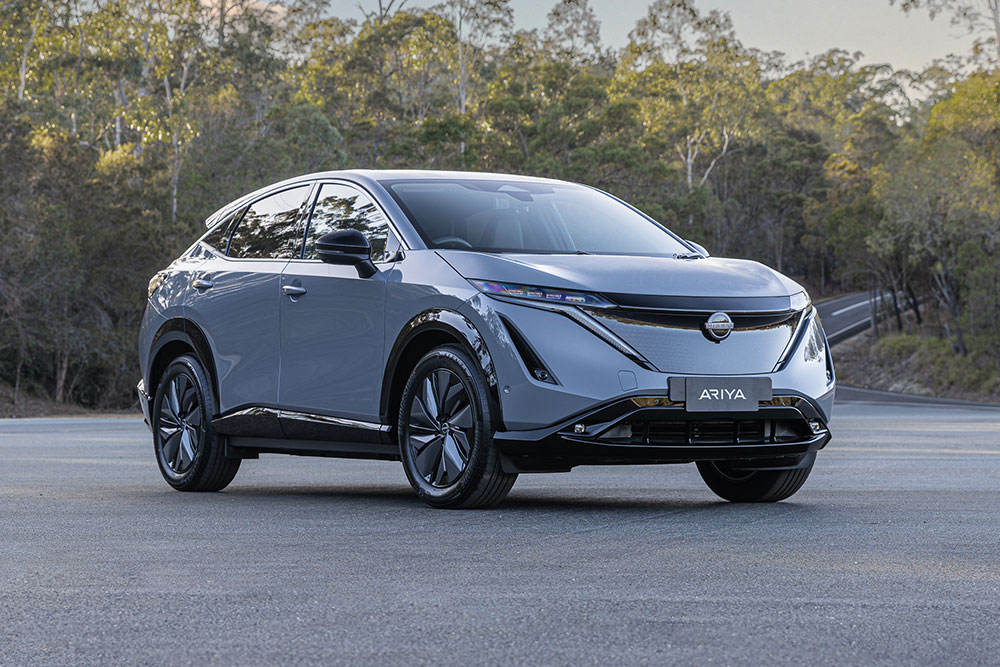Nissan Ariya electric car headed to Australia in 2024
Nissan’s efforts to regain the leadership it briefly enjoyed in Australian electric vehicle sales have taken a hit with the news that its hero product the Nissan Ariya EV won’t arrive here until 2024.

Nissan was an early mover in the electric vehicle (EV) space, launching its ground-breaking Leaf in December 2010, but has failed to capitalise on that momentum by adding additional models since.
As at July this year, the Leaf had managed 287 sales year to date, versus 12,179 sales for its nearest Tesla rival the Model 3, with Tesla also racking up 17,332 sales of the Model Y SUV over the same period.
Globally, Tesla is showing most western brands a clean rear number plate when it comes to EV sales and Nissan’s new Ariya SUV is intended to wrest back some of that dominance.
First revealed in 2020, the Ariya has been on sale in Japan since mid-2021 and the United States since 2022, so it was hoped the new model might find its way to Australian shores sometime in 2023.

However, the Managing Director of Nissan Asia and Oceania, Guillaume Cartier, said at a recent prototype drive day of the new model that delays in the Australian homologation process and supply shortages meant the car’s local launch would be delayed until 2024.
This means that when the Ariya eventually does land here it will be more than four years old and halfway through its expected model cycle.
One possible upside to the protracted delay is that Australian models may benefit from the mid-life updates already sighted on overseas test models.
While Nissan Australia plays the waiting game, the Ariya’s mid-sized SUV rivals including the Kia EV6, Hyundai Ioniq 5 and Tesla Model Y are riding the gathering wave of EV sales in this country.
Based on its overseas specifications, the Ariya crossover has what it takes to compete with these models, featuring as it does either a 63kWh or 87kWh battery pack, two or all-wheel drive, DC fast charging up to 130kW, and a 530km driving range on the WLTP cycle.
Find out about RACQ Roadside Assistance for EVs
Other notable features of the Ariya, depending on variant, include Nissan’s e-4ORCE all-wheel-drive system and its ProPilot 2.0 advanced driver assistance systems, both of which have already been introduced here on Nissan’s current range of SUVs.
The European-spec Ariya we briefly sampled at RACQ’s Mount Cotton Mobility Centre was quiet, smooth and responsive, combining three different drive modes – normal, eco and sport.
With weight distribution close to 50/50, and a decently quick 14:1 steering ratio the Nissan EV felt suitably dynamic through the bends, although it’s positioned more as a family hauler than a performance model.
Nevertheless, the instant torque of its electric motors ensured it had ample acceleration and the overall combination felt lively and fun to drive.
Puzzlingly, despite being built on a dedicated EV skateboard platform with its battery weight sited low in the vehicle structure, the Ariya displayed quite a bit of body roll through bends.

This suggests it may have a high centre of gravity, or lacks sufficiently disciplined body control, something Nissan Australia will no doubt investigate before the vehicle’s local launch.
Stylistically, Nissan describes the Ariya’s design as “timeless Japanese futurism,” whatever that means.
Certainly, it’s an attractive-looking vehicle with distinctive styling that won accolades in the Auto Color Award 2021 Grand Prix in Japan and Germany’s prestigious Red Dot Design Award.
The impressively well-finished interior boasts plenty of tech including two 12.3-inch screens with customisable apps that can be moved from screen to screen.
Other notable features include head-up display, an electric sliding centre console, and both double-glazed windows and thick carpet for reduced road noise.

A series of haptic buttons for the HVAC system integrated into the panel below the touchscreen offer a nice compromise between physical switches and Tesla’s full touchscreen integration of most switches.
Our limited time at the wheel under controlled conditions means we will have to reserve final judgement on the Ariya until local tuning, specification and pricing are announced closer to the release date, but the initial impressions are very positive.
Meanwhile, Nissan announced in late July that its global sales of electric vehicles had surpassed the one-million-unit milestone.
The Nissan Leaf was the biggest contributor to that total, with the Ariya and the Japanese-market Sakura mini-vehicle also contributing to the total.
Under its Nissan Ambition 2030 long-term vision, Nissan plans to launch 19 EV models by fiscal year 2030.
The company also aims to launch EVs powered by solid-state batteries, developed in-house, by fiscal year 2028.
STORY BY ANDREW KIRK, GED BULMER
Related topics
Things to note
The information in this article has been prepared for general information purposes only and is not intended as legal advice or specific advice to any particular person. Any advice contained in the document is general advice, not intended as legal advice or professional advice and does not take into account any person’s particular circumstances. Before acting on anything based on this advice you should consider its appropriateness to you, having regard to your objectives and needs.
Insurance Products (excluding Travel Insurance) are issued by RACQ Insurance Limited ABN 50 009 704 152 (RACQI) and arranged by its agent, RACQ Distribution Services Pty Ltd (RDS) ABN 35 116 361 650, AFSL 567130 and RDS' authorised representatives (including RACQ Operations Pty Ltd ABN 80 009 663 414, AR No. 234978 (RACQO). Conditions, limits and exclusions apply. RDS and RACQO are in the RACQ group of companies. One of the companies in the RACQ group of companies has a minority shareholding in RACQI.
RDS and RACQO have not taken your personal objectives, circumstances or needs into account when preparing advice regarding insurance products and you will need to consider whether the advice is appropriate for you. Read the Product Disclosure Statement (PDS) and any applicable Supplementary PDS before making a purchase decision on this product. You can also access our Target Market Determinations on this website. RDS receives a commission from RACQI for the policies it arranges. RACQO receives fees paid for services it provides to RDS. Further details about remuneration are available on request prior to purchasing.
Banking and loan products issued by Members Banking Group Limited ABN 83 087 651 054 AFSL/Australian credit licence 241195 trading as RACQ Bank. Terms, conditions, fees, charges and lending policies apply. This is general advice only and may not be right for you. This information does not take your personal objectives, circumstances or needs into account. Read the disclosure documents for your selected product or service, including the Financial Services Guide and the Terms and Conditions, and consider if appropriate for you before deciding.
Except for RACQ Bank, any RACQ entity referred to on this page is not an authorised deposit-taking institution for the purposes of the Banking Act 1959 (Cth). That entity’s obligations do not represent deposits or other liabilities of RACQ Bank. RACQ Bank does not guarantee or otherwise provide assurance in respect of the obligations of that entity, unless noted otherwise.
RACQ Bank subscribes to the Customer Owned Banking Code of Practice which establishes higher standards than the law requires. The Code reflects modern consumer expectations and developments in approaches to issues such as consumer vulnerability, guarantors, and supporting customers through financial hardship. Please read our Customer Owned Banking Code of Practice page for more information.
RACQ Operations Pty Ltd (ABN 80 009 663 414 AR 000234978) and Members Travel Group Pty Ltd (ABN 45 144 538 803 AR 000432492) are acting as an Authorised Representative of the issuer of the insurance, Tokio Marine & Nichido Fire Insurance Co., Ltd. (ABN 80 000 438 291 AFSL 246 548). Any advice set out above is general in nature only, and does not take into account your objectives, financial situation or needs. Before purchasing any travel products, please consider the RACQ Travel Insurance Product Disclosure Statement (PDS) and the Target Market Determinations (TMDs) that apply to these products. Whilst the PDS outlines the Terms and Conditions of these products, the TMDs outline the intended class of customers that comprise the target market for these travel products. This will allow you to consider which products best suit your objectives, financial situation and needs and consider the products appropriateness to your personal circumstances. TMDs also outline matters involving the distribution and the review of these products. The PDS, Supplementary PDS and TMDs for each travel product can be found here.

